HRD in Care Organisations: Roles, Practices, & Ethics Analysis
VerifiedAdded on 2020/02/03
|11
|3288
|348
Report
AI Summary
This report analyzes the crucial role of Human Resource Development (HRD) within care organizations, addressing key practices, ethical considerations, and contributions to employee and organizational development. It examines the responsibilities of HRD in staffing, employee management, and legal compliance, highlighting the significance of work-life balance, training, and compensation. The report evaluates HR's impact on employee growth, linking these contributions to the overall success of care homes. It identifies ethical issues related to workforce management, training, and workplace standards. Finally, the report applies HRD principles, offering recommendations for care homes facing challenges, such as addressing training gaps, improving service user care, and ensuring safeguarding measures.
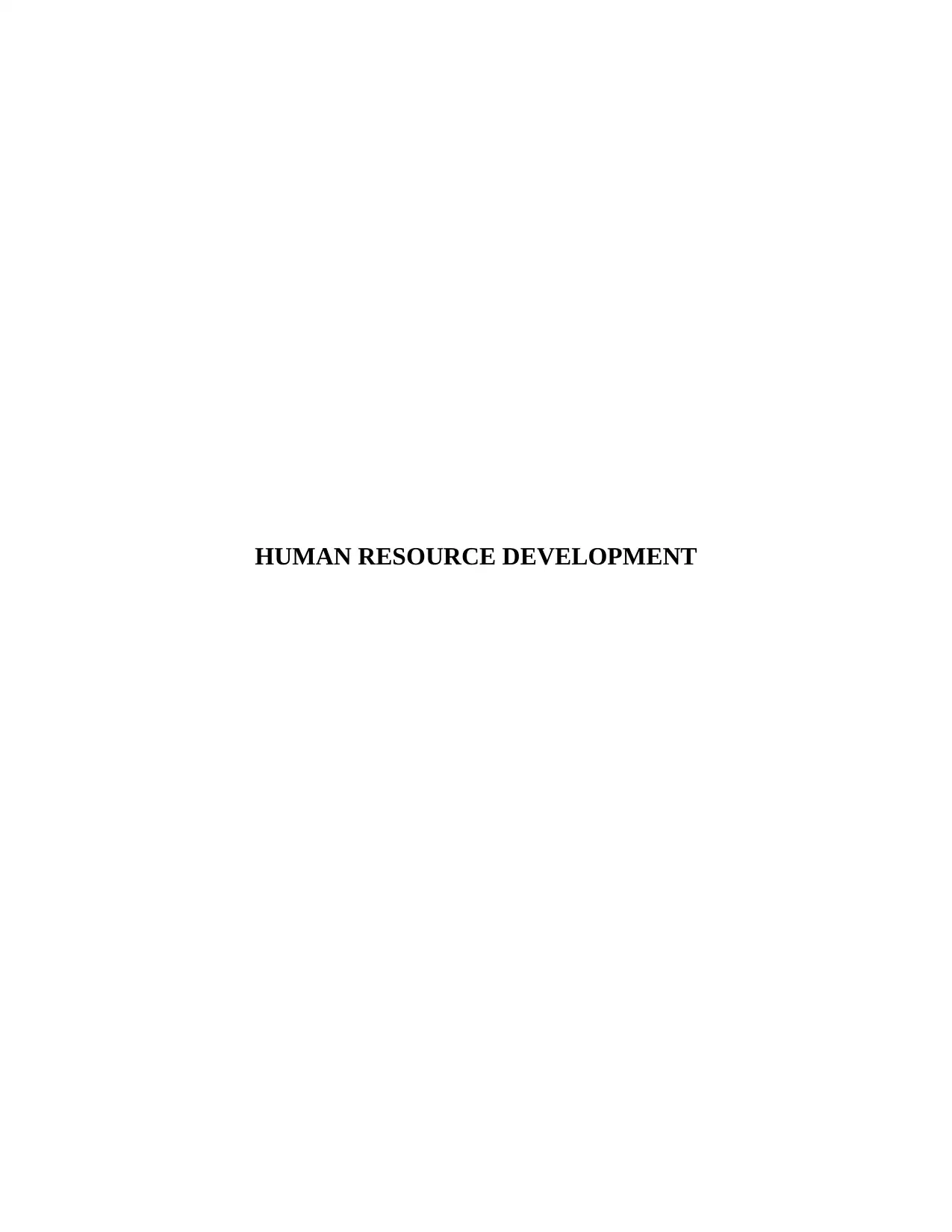
HUMAN RESOURCE DEVELOPMENT
Paraphrase This Document
Need a fresh take? Get an instant paraphrase of this document with our AI Paraphraser
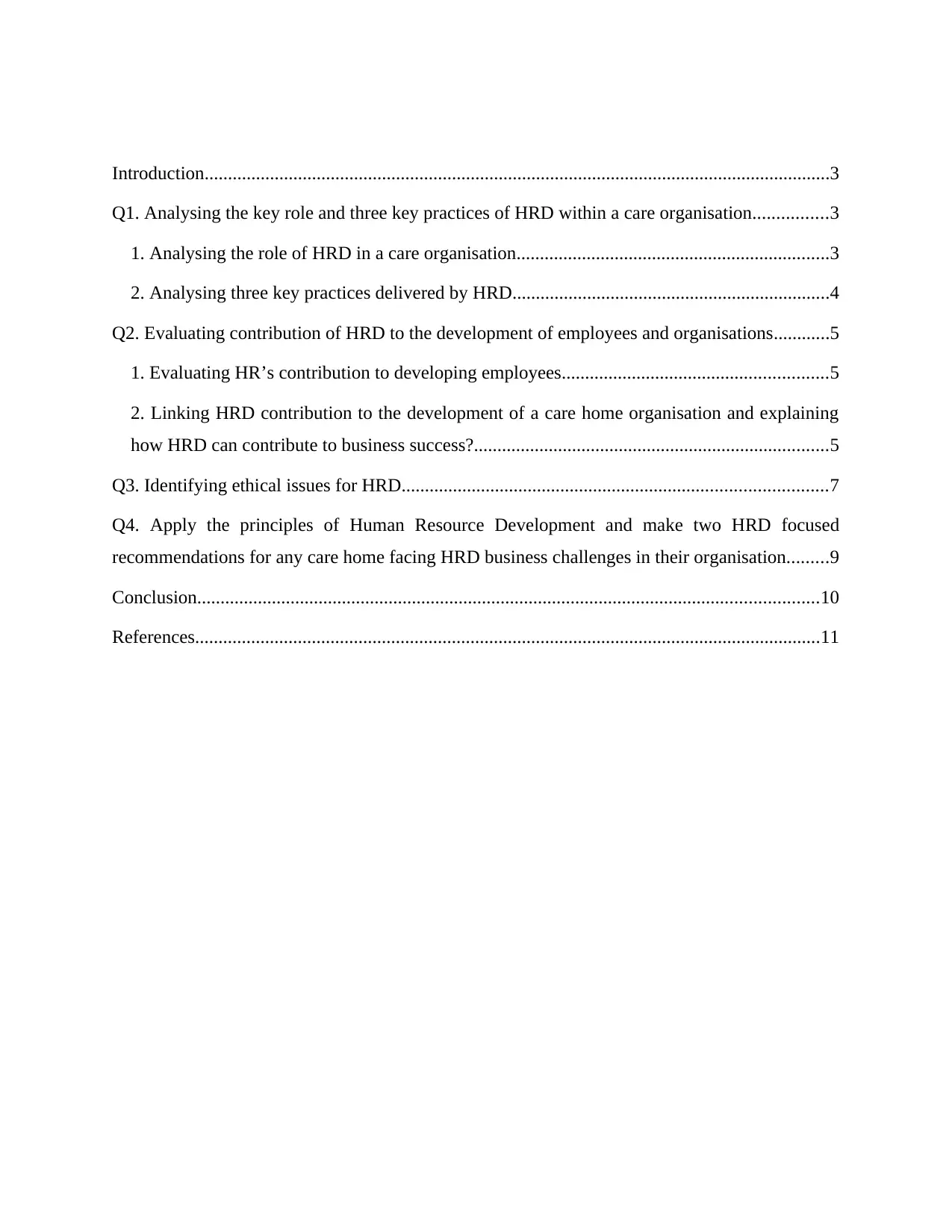
Introduction......................................................................................................................................3
Q1. Analysing the key role and three key practices of HRD within a care organisation................3
1. Analysing the role of HRD in a care organisation...................................................................3
2. Analysing three key practices delivered by HRD....................................................................4
Q2. Evaluating contribution of HRD to the development of employees and organisations............5
1. Evaluating HR’s contribution to developing employees.........................................................5
2. Linking HRD contribution to the development of a care home organisation and explaining
how HRD can contribute to business success?............................................................................5
Q3. Identifying ethical issues for HRD...........................................................................................7
Q4. Apply the principles of Human Resource Development and make two HRD focused
recommendations for any care home facing HRD business challenges in their organisation.........9
Conclusion.....................................................................................................................................10
References......................................................................................................................................11
Q1. Analysing the key role and three key practices of HRD within a care organisation................3
1. Analysing the role of HRD in a care organisation...................................................................3
2. Analysing three key practices delivered by HRD....................................................................4
Q2. Evaluating contribution of HRD to the development of employees and organisations............5
1. Evaluating HR’s contribution to developing employees.........................................................5
2. Linking HRD contribution to the development of a care home organisation and explaining
how HRD can contribute to business success?............................................................................5
Q3. Identifying ethical issues for HRD...........................................................................................7
Q4. Apply the principles of Human Resource Development and make two HRD focused
recommendations for any care home facing HRD business challenges in their organisation.........9
Conclusion.....................................................................................................................................10
References......................................................................................................................................11
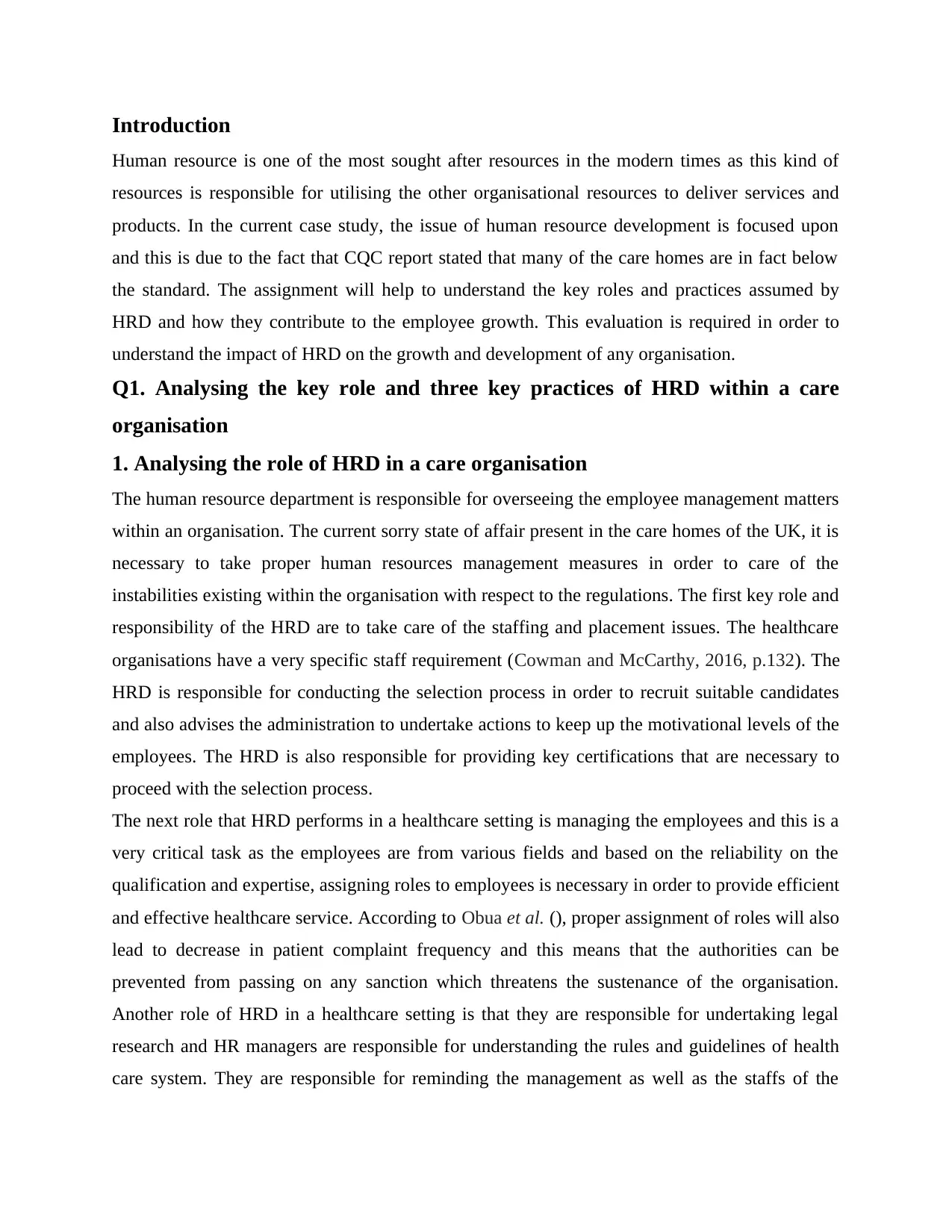
Introduction
Human resource is one of the most sought after resources in the modern times as this kind of
resources is responsible for utilising the other organisational resources to deliver services and
products. In the current case study, the issue of human resource development is focused upon
and this is due to the fact that CQC report stated that many of the care homes are in fact below
the standard. The assignment will help to understand the key roles and practices assumed by
HRD and how they contribute to the employee growth. This evaluation is required in order to
understand the impact of HRD on the growth and development of any organisation.
Q1. Analysing the key role and three key practices of HRD within a care
organisation
1. Analysing the role of HRD in a care organisation
The human resource department is responsible for overseeing the employee management matters
within an organisation. The current sorry state of affair present in the care homes of the UK, it is
necessary to take proper human resources management measures in order to care of the
instabilities existing within the organisation with respect to the regulations. The first key role and
responsibility of the HRD are to take care of the staffing and placement issues. The healthcare
organisations have a very specific staff requirement (Cowman and McCarthy, 2016, p.132). The
HRD is responsible for conducting the selection process in order to recruit suitable candidates
and also advises the administration to undertake actions to keep up the motivational levels of the
employees. The HRD is also responsible for providing key certifications that are necessary to
proceed with the selection process.
The next role that HRD performs in a healthcare setting is managing the employees and this is a
very critical task as the employees are from various fields and based on the reliability on the
qualification and expertise, assigning roles to employees is necessary in order to provide efficient
and effective healthcare service. According to Obua et al. (), proper assignment of roles will also
lead to decrease in patient complaint frequency and this means that the authorities can be
prevented from passing on any sanction which threatens the sustenance of the organisation.
Another role of HRD in a healthcare setting is that they are responsible for undertaking legal
research and HR managers are responsible for understanding the rules and guidelines of health
care system. They are responsible for reminding the management as well as the staffs of the
Human resource is one of the most sought after resources in the modern times as this kind of
resources is responsible for utilising the other organisational resources to deliver services and
products. In the current case study, the issue of human resource development is focused upon
and this is due to the fact that CQC report stated that many of the care homes are in fact below
the standard. The assignment will help to understand the key roles and practices assumed by
HRD and how they contribute to the employee growth. This evaluation is required in order to
understand the impact of HRD on the growth and development of any organisation.
Q1. Analysing the key role and three key practices of HRD within a care
organisation
1. Analysing the role of HRD in a care organisation
The human resource department is responsible for overseeing the employee management matters
within an organisation. The current sorry state of affair present in the care homes of the UK, it is
necessary to take proper human resources management measures in order to care of the
instabilities existing within the organisation with respect to the regulations. The first key role and
responsibility of the HRD are to take care of the staffing and placement issues. The healthcare
organisations have a very specific staff requirement (Cowman and McCarthy, 2016, p.132). The
HRD is responsible for conducting the selection process in order to recruit suitable candidates
and also advises the administration to undertake actions to keep up the motivational levels of the
employees. The HRD is also responsible for providing key certifications that are necessary to
proceed with the selection process.
The next role that HRD performs in a healthcare setting is managing the employees and this is a
very critical task as the employees are from various fields and based on the reliability on the
qualification and expertise, assigning roles to employees is necessary in order to provide efficient
and effective healthcare service. According to Obua et al. (), proper assignment of roles will also
lead to decrease in patient complaint frequency and this means that the authorities can be
prevented from passing on any sanction which threatens the sustenance of the organisation.
Another role of HRD in a healthcare setting is that they are responsible for undertaking legal
research and HR managers are responsible for understanding the rules and guidelines of health
care system. They are responsible for reminding the management as well as the staffs of the
⊘ This is a preview!⊘
Do you want full access?
Subscribe today to unlock all pages.

Trusted by 1+ million students worldwide
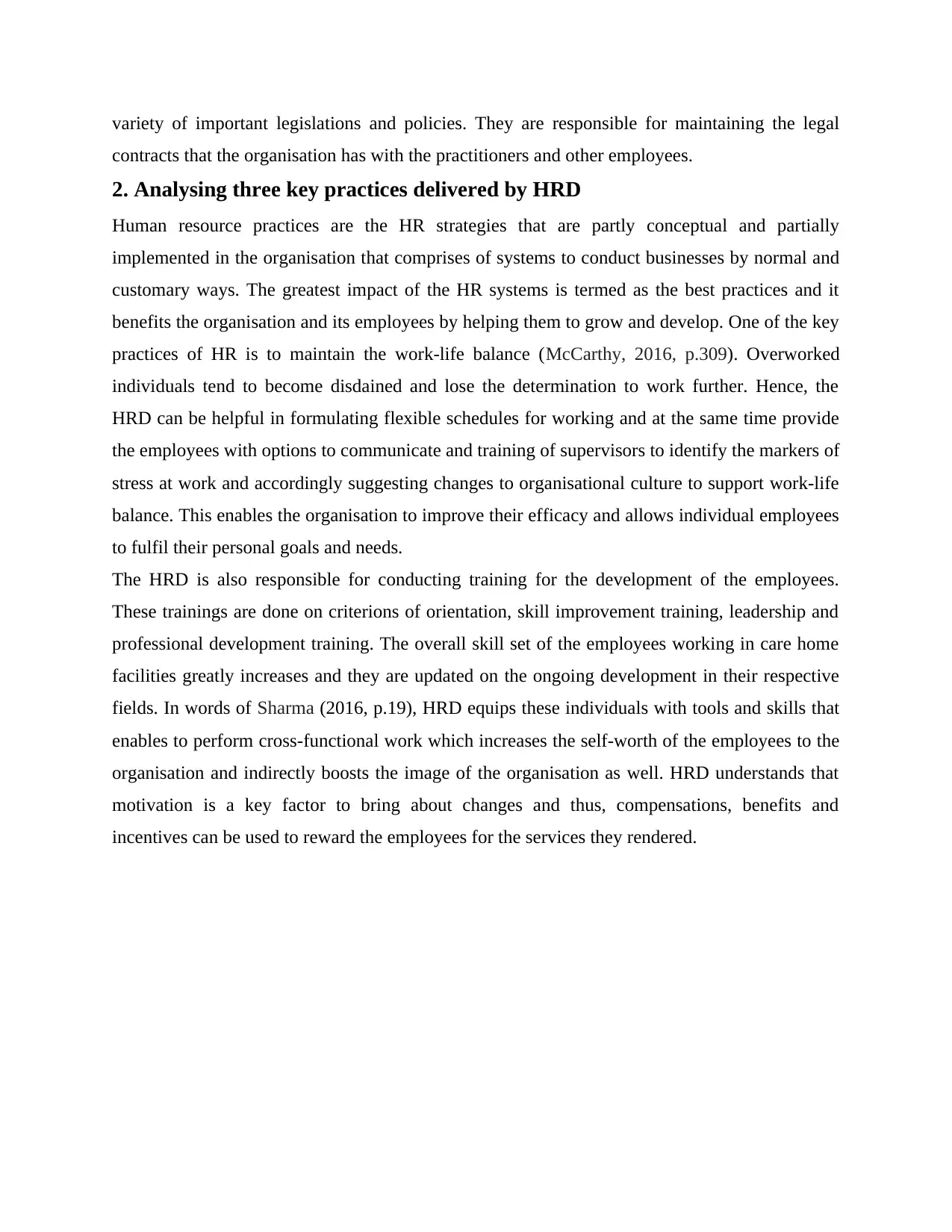
variety of important legislations and policies. They are responsible for maintaining the legal
contracts that the organisation has with the practitioners and other employees.
2. Analysing three key practices delivered by HRD
Human resource practices are the HR strategies that are partly conceptual and partially
implemented in the organisation that comprises of systems to conduct businesses by normal and
customary ways. The greatest impact of the HR systems is termed as the best practices and it
benefits the organisation and its employees by helping them to grow and develop. One of the key
practices of HR is to maintain the work-life balance (McCarthy, 2016, p.309). Overworked
individuals tend to become disdained and lose the determination to work further. Hence, the
HRD can be helpful in formulating flexible schedules for working and at the same time provide
the employees with options to communicate and training of supervisors to identify the markers of
stress at work and accordingly suggesting changes to organisational culture to support work-life
balance. This enables the organisation to improve their efficacy and allows individual employees
to fulfil their personal goals and needs.
The HRD is also responsible for conducting training for the development of the employees.
These trainings are done on criterions of orientation, skill improvement training, leadership and
professional development training. The overall skill set of the employees working in care home
facilities greatly increases and they are updated on the ongoing development in their respective
fields. In words of Sharma (2016, p.19), HRD equips these individuals with tools and skills that
enables to perform cross-functional work which increases the self-worth of the employees to the
organisation and indirectly boosts the image of the organisation as well. HRD understands that
motivation is a key factor to bring about changes and thus, compensations, benefits and
incentives can be used to reward the employees for the services they rendered.
contracts that the organisation has with the practitioners and other employees.
2. Analysing three key practices delivered by HRD
Human resource practices are the HR strategies that are partly conceptual and partially
implemented in the organisation that comprises of systems to conduct businesses by normal and
customary ways. The greatest impact of the HR systems is termed as the best practices and it
benefits the organisation and its employees by helping them to grow and develop. One of the key
practices of HR is to maintain the work-life balance (McCarthy, 2016, p.309). Overworked
individuals tend to become disdained and lose the determination to work further. Hence, the
HRD can be helpful in formulating flexible schedules for working and at the same time provide
the employees with options to communicate and training of supervisors to identify the markers of
stress at work and accordingly suggesting changes to organisational culture to support work-life
balance. This enables the organisation to improve their efficacy and allows individual employees
to fulfil their personal goals and needs.
The HRD is also responsible for conducting training for the development of the employees.
These trainings are done on criterions of orientation, skill improvement training, leadership and
professional development training. The overall skill set of the employees working in care home
facilities greatly increases and they are updated on the ongoing development in their respective
fields. In words of Sharma (2016, p.19), HRD equips these individuals with tools and skills that
enables to perform cross-functional work which increases the self-worth of the employees to the
organisation and indirectly boosts the image of the organisation as well. HRD understands that
motivation is a key factor to bring about changes and thus, compensations, benefits and
incentives can be used to reward the employees for the services they rendered.
Paraphrase This Document
Need a fresh take? Get an instant paraphrase of this document with our AI Paraphraser
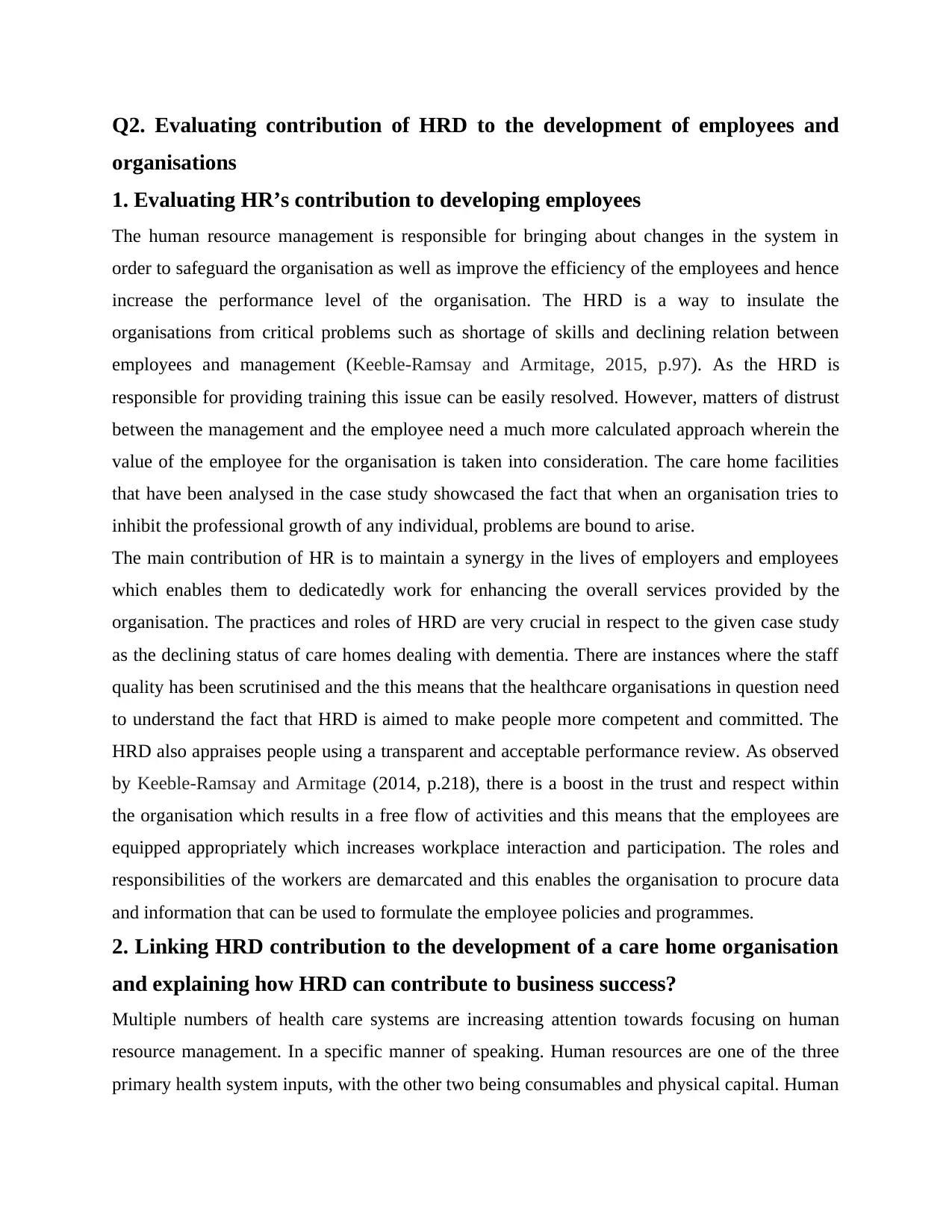
Q2. Evaluating contribution of HRD to the development of employees and
organisations
1. Evaluating HR’s contribution to developing employees
The human resource management is responsible for bringing about changes in the system in
order to safeguard the organisation as well as improve the efficiency of the employees and hence
increase the performance level of the organisation. The HRD is a way to insulate the
organisations from critical problems such as shortage of skills and declining relation between
employees and management (Keeble-Ramsay and Armitage, 2015, p.97). As the HRD is
responsible for providing training this issue can be easily resolved. However, matters of distrust
between the management and the employee need a much more calculated approach wherein the
value of the employee for the organisation is taken into consideration. The care home facilities
that have been analysed in the case study showcased the fact that when an organisation tries to
inhibit the professional growth of any individual, problems are bound to arise.
The main contribution of HR is to maintain a synergy in the lives of employers and employees
which enables them to dedicatedly work for enhancing the overall services provided by the
organisation. The practices and roles of HRD are very crucial in respect to the given case study
as the declining status of care homes dealing with dementia. There are instances where the staff
quality has been scrutinised and the this means that the healthcare organisations in question need
to understand the fact that HRD is aimed to make people more competent and committed. The
HRD also appraises people using a transparent and acceptable performance review. As observed
by Keeble-Ramsay and Armitage (2014, p.218), there is a boost in the trust and respect within
the organisation which results in a free flow of activities and this means that the employees are
equipped appropriately which increases workplace interaction and participation. The roles and
responsibilities of the workers are demarcated and this enables the organisation to procure data
and information that can be used to formulate the employee policies and programmes.
2. Linking HRD contribution to the development of a care home organisation
and explaining how HRD can contribute to business success?
Multiple numbers of health care systems are increasing attention towards focusing on human
resource management. In a specific manner of speaking. Human resources are one of the three
primary health system inputs, with the other two being consumables and physical capital. Human
organisations
1. Evaluating HR’s contribution to developing employees
The human resource management is responsible for bringing about changes in the system in
order to safeguard the organisation as well as improve the efficiency of the employees and hence
increase the performance level of the organisation. The HRD is a way to insulate the
organisations from critical problems such as shortage of skills and declining relation between
employees and management (Keeble-Ramsay and Armitage, 2015, p.97). As the HRD is
responsible for providing training this issue can be easily resolved. However, matters of distrust
between the management and the employee need a much more calculated approach wherein the
value of the employee for the organisation is taken into consideration. The care home facilities
that have been analysed in the case study showcased the fact that when an organisation tries to
inhibit the professional growth of any individual, problems are bound to arise.
The main contribution of HR is to maintain a synergy in the lives of employers and employees
which enables them to dedicatedly work for enhancing the overall services provided by the
organisation. The practices and roles of HRD are very crucial in respect to the given case study
as the declining status of care homes dealing with dementia. There are instances where the staff
quality has been scrutinised and the this means that the healthcare organisations in question need
to understand the fact that HRD is aimed to make people more competent and committed. The
HRD also appraises people using a transparent and acceptable performance review. As observed
by Keeble-Ramsay and Armitage (2014, p.218), there is a boost in the trust and respect within
the organisation which results in a free flow of activities and this means that the employees are
equipped appropriately which increases workplace interaction and participation. The roles and
responsibilities of the workers are demarcated and this enables the organisation to procure data
and information that can be used to formulate the employee policies and programmes.
2. Linking HRD contribution to the development of a care home organisation
and explaining how HRD can contribute to business success?
Multiple numbers of health care systems are increasing attention towards focusing on human
resource management. In a specific manner of speaking. Human resources are one of the three
primary health system inputs, with the other two being consumables and physical capital. Human
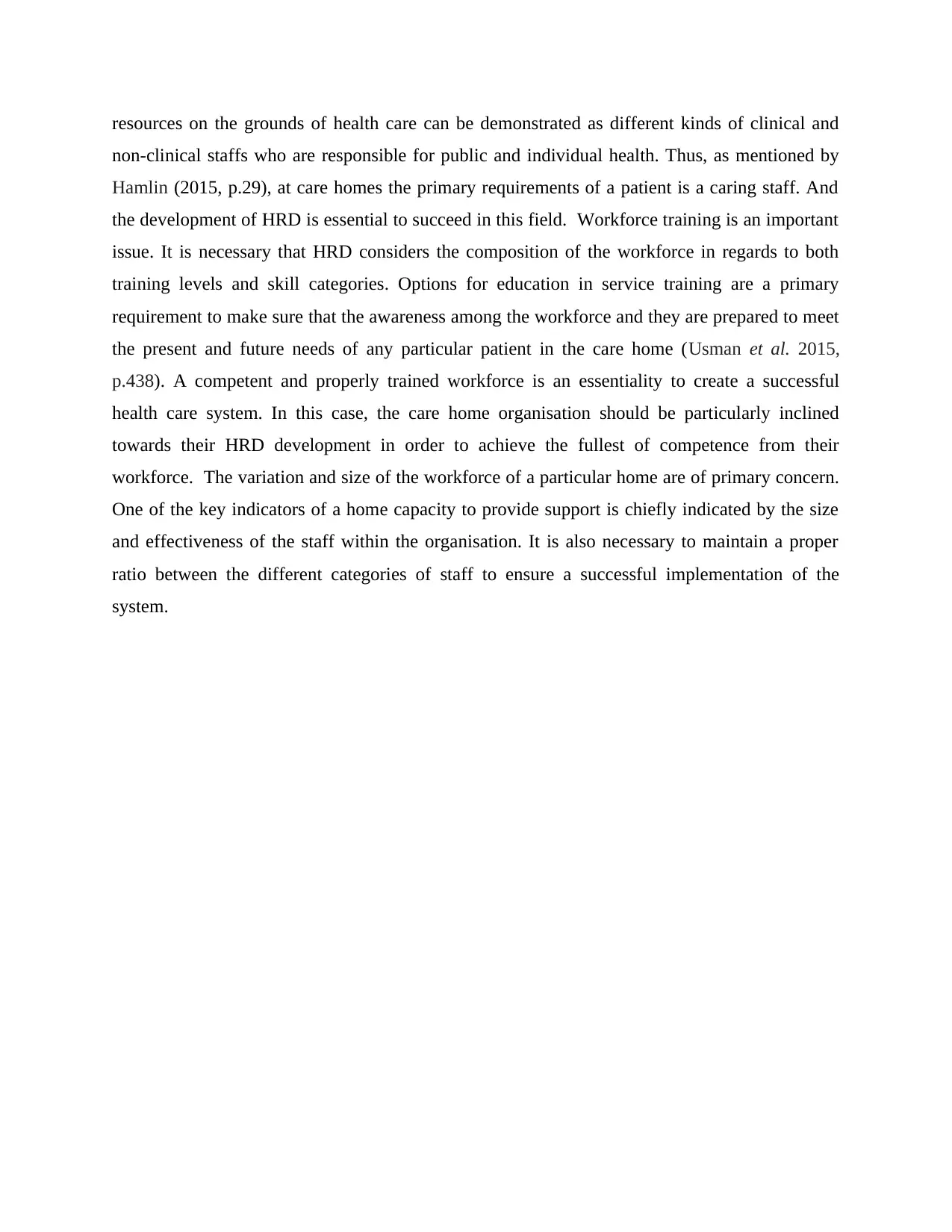
resources on the grounds of health care can be demonstrated as different kinds of clinical and
non-clinical staffs who are responsible for public and individual health. Thus, as mentioned by
Hamlin (2015, p.29), at care homes the primary requirements of a patient is a caring staff. And
the development of HRD is essential to succeed in this field. Workforce training is an important
issue. It is necessary that HRD considers the composition of the workforce in regards to both
training levels and skill categories. Options for education in service training are a primary
requirement to make sure that the awareness among the workforce and they are prepared to meet
the present and future needs of any particular patient in the care home (Usman et al. 2015,
p.438). A competent and properly trained workforce is an essentiality to create a successful
health care system. In this case, the care home organisation should be particularly inclined
towards their HRD development in order to achieve the fullest of competence from their
workforce. The variation and size of the workforce of a particular home are of primary concern.
One of the key indicators of a home capacity to provide support is chiefly indicated by the size
and effectiveness of the staff within the organisation. It is also necessary to maintain a proper
ratio between the different categories of staff to ensure a successful implementation of the
system.
non-clinical staffs who are responsible for public and individual health. Thus, as mentioned by
Hamlin (2015, p.29), at care homes the primary requirements of a patient is a caring staff. And
the development of HRD is essential to succeed in this field. Workforce training is an important
issue. It is necessary that HRD considers the composition of the workforce in regards to both
training levels and skill categories. Options for education in service training are a primary
requirement to make sure that the awareness among the workforce and they are prepared to meet
the present and future needs of any particular patient in the care home (Usman et al. 2015,
p.438). A competent and properly trained workforce is an essentiality to create a successful
health care system. In this case, the care home organisation should be particularly inclined
towards their HRD development in order to achieve the fullest of competence from their
workforce. The variation and size of the workforce of a particular home are of primary concern.
One of the key indicators of a home capacity to provide support is chiefly indicated by the size
and effectiveness of the staff within the organisation. It is also necessary to maintain a proper
ratio between the different categories of staff to ensure a successful implementation of the
system.
⊘ This is a preview!⊘
Do you want full access?
Subscribe today to unlock all pages.

Trusted by 1+ million students worldwide
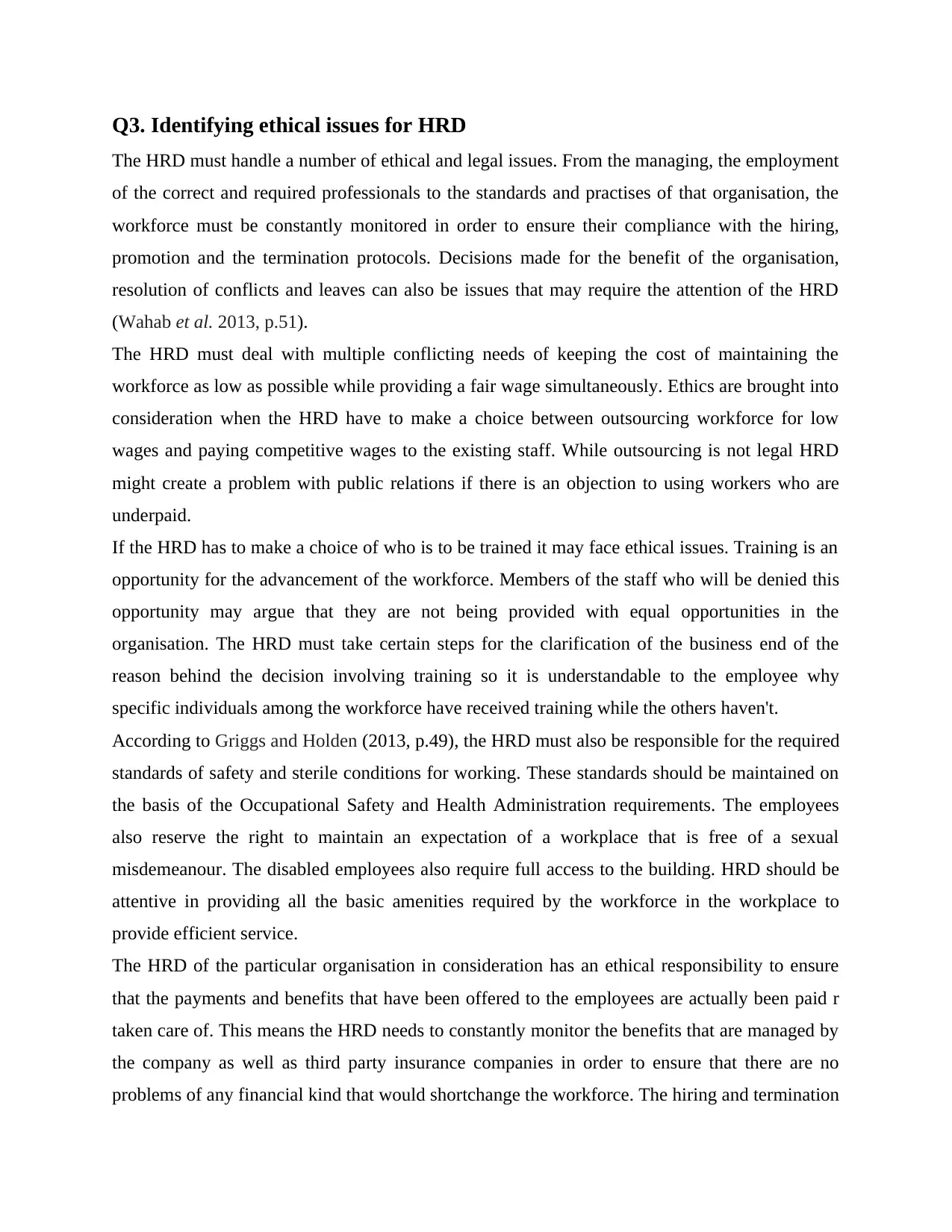
Q3. Identifying ethical issues for HRD
The HRD must handle a number of ethical and legal issues. From the managing, the employment
of the correct and required professionals to the standards and practises of that organisation, the
workforce must be constantly monitored in order to ensure their compliance with the hiring,
promotion and the termination protocols. Decisions made for the benefit of the organisation,
resolution of conflicts and leaves can also be issues that may require the attention of the HRD
(Wahab et al. 2013, p.51).
The HRD must deal with multiple conflicting needs of keeping the cost of maintaining the
workforce as low as possible while providing a fair wage simultaneously. Ethics are brought into
consideration when the HRD have to make a choice between outsourcing workforce for low
wages and paying competitive wages to the existing staff. While outsourcing is not legal HRD
might create a problem with public relations if there is an objection to using workers who are
underpaid.
If the HRD has to make a choice of who is to be trained it may face ethical issues. Training is an
opportunity for the advancement of the workforce. Members of the staff who will be denied this
opportunity may argue that they are not being provided with equal opportunities in the
organisation. The HRD must take certain steps for the clarification of the business end of the
reason behind the decision involving training so it is understandable to the employee why
specific individuals among the workforce have received training while the others haven't.
According to Griggs and Holden (2013, p.49), the HRD must also be responsible for the required
standards of safety and sterile conditions for working. These standards should be maintained on
the basis of the Occupational Safety and Health Administration requirements. The employees
also reserve the right to maintain an expectation of a workplace that is free of a sexual
misdemeanour. The disabled employees also require full access to the building. HRD should be
attentive in providing all the basic amenities required by the workforce in the workplace to
provide efficient service.
The HRD of the particular organisation in consideration has an ethical responsibility to ensure
that the payments and benefits that have been offered to the employees are actually been paid r
taken care of. This means the HRD needs to constantly monitor the benefits that are managed by
the company as well as third party insurance companies in order to ensure that there are no
problems of any financial kind that would shortchange the workforce. The hiring and termination
The HRD must handle a number of ethical and legal issues. From the managing, the employment
of the correct and required professionals to the standards and practises of that organisation, the
workforce must be constantly monitored in order to ensure their compliance with the hiring,
promotion and the termination protocols. Decisions made for the benefit of the organisation,
resolution of conflicts and leaves can also be issues that may require the attention of the HRD
(Wahab et al. 2013, p.51).
The HRD must deal with multiple conflicting needs of keeping the cost of maintaining the
workforce as low as possible while providing a fair wage simultaneously. Ethics are brought into
consideration when the HRD have to make a choice between outsourcing workforce for low
wages and paying competitive wages to the existing staff. While outsourcing is not legal HRD
might create a problem with public relations if there is an objection to using workers who are
underpaid.
If the HRD has to make a choice of who is to be trained it may face ethical issues. Training is an
opportunity for the advancement of the workforce. Members of the staff who will be denied this
opportunity may argue that they are not being provided with equal opportunities in the
organisation. The HRD must take certain steps for the clarification of the business end of the
reason behind the decision involving training so it is understandable to the employee why
specific individuals among the workforce have received training while the others haven't.
According to Griggs and Holden (2013, p.49), the HRD must also be responsible for the required
standards of safety and sterile conditions for working. These standards should be maintained on
the basis of the Occupational Safety and Health Administration requirements. The employees
also reserve the right to maintain an expectation of a workplace that is free of a sexual
misdemeanour. The disabled employees also require full access to the building. HRD should be
attentive in providing all the basic amenities required by the workforce in the workplace to
provide efficient service.
The HRD of the particular organisation in consideration has an ethical responsibility to ensure
that the payments and benefits that have been offered to the employees are actually been paid r
taken care of. This means the HRD needs to constantly monitor the benefits that are managed by
the company as well as third party insurance companies in order to ensure that there are no
problems of any financial kind that would shortchange the workforce. The hiring and termination
Paraphrase This Document
Need a fresh take? Get an instant paraphrase of this document with our AI Paraphraser

decisions should be made wisely and without any regard to ethnicity, gender, sexual preference
or religious beliefs. The HRD must take precaution in this matter to eliminate bias processes of
hiring and firing and make sure that such actions are strictly for the purpose of business.
or religious beliefs. The HRD must take precaution in this matter to eliminate bias processes of
hiring and firing and make sure that such actions are strictly for the purpose of business.
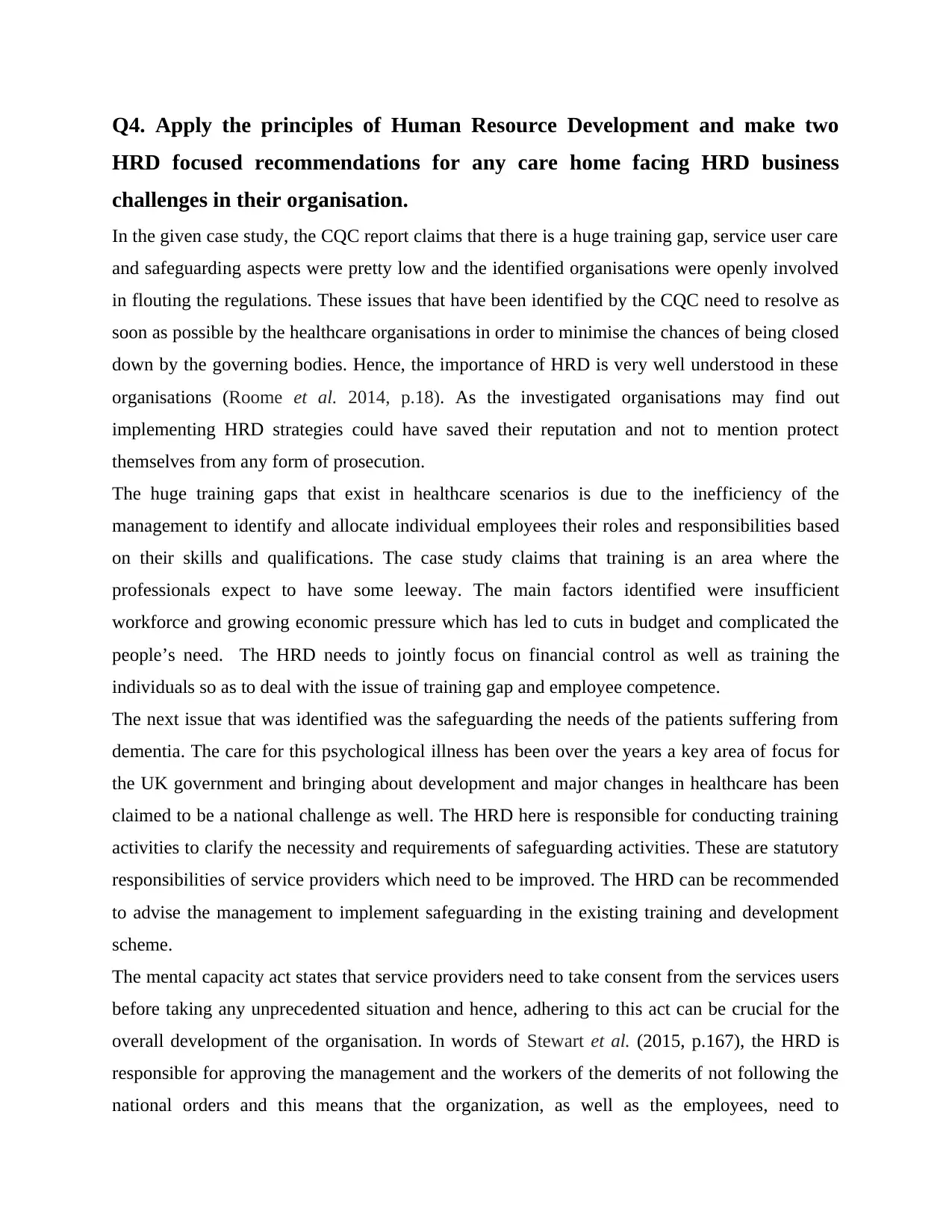
Q4. Apply the principles of Human Resource Development and make two
HRD focused recommendations for any care home facing HRD business
challenges in their organisation.
In the given case study, the CQC report claims that there is a huge training gap, service user care
and safeguarding aspects were pretty low and the identified organisations were openly involved
in flouting the regulations. These issues that have been identified by the CQC need to resolve as
soon as possible by the healthcare organisations in order to minimise the chances of being closed
down by the governing bodies. Hence, the importance of HRD is very well understood in these
organisations (Roome et al. 2014, p.18). As the investigated organisations may find out
implementing HRD strategies could have saved their reputation and not to mention protect
themselves from any form of prosecution.
The huge training gaps that exist in healthcare scenarios is due to the inefficiency of the
management to identify and allocate individual employees their roles and responsibilities based
on their skills and qualifications. The case study claims that training is an area where the
professionals expect to have some leeway. The main factors identified were insufficient
workforce and growing economic pressure which has led to cuts in budget and complicated the
people’s need. The HRD needs to jointly focus on financial control as well as training the
individuals so as to deal with the issue of training gap and employee competence.
The next issue that was identified was the safeguarding the needs of the patients suffering from
dementia. The care for this psychological illness has been over the years a key area of focus for
the UK government and bringing about development and major changes in healthcare has been
claimed to be a national challenge as well. The HRD here is responsible for conducting training
activities to clarify the necessity and requirements of safeguarding activities. These are statutory
responsibilities of service providers which need to be improved. The HRD can be recommended
to advise the management to implement safeguarding in the existing training and development
scheme.
The mental capacity act states that service providers need to take consent from the services users
before taking any unprecedented situation and hence, adhering to this act can be crucial for the
overall development of the organisation. In words of Stewart et al. (2015, p.167), the HRD is
responsible for approving the management and the workers of the demerits of not following the
national orders and this means that the organization, as well as the employees, need to
HRD focused recommendations for any care home facing HRD business
challenges in their organisation.
In the given case study, the CQC report claims that there is a huge training gap, service user care
and safeguarding aspects were pretty low and the identified organisations were openly involved
in flouting the regulations. These issues that have been identified by the CQC need to resolve as
soon as possible by the healthcare organisations in order to minimise the chances of being closed
down by the governing bodies. Hence, the importance of HRD is very well understood in these
organisations (Roome et al. 2014, p.18). As the investigated organisations may find out
implementing HRD strategies could have saved their reputation and not to mention protect
themselves from any form of prosecution.
The huge training gaps that exist in healthcare scenarios is due to the inefficiency of the
management to identify and allocate individual employees their roles and responsibilities based
on their skills and qualifications. The case study claims that training is an area where the
professionals expect to have some leeway. The main factors identified were insufficient
workforce and growing economic pressure which has led to cuts in budget and complicated the
people’s need. The HRD needs to jointly focus on financial control as well as training the
individuals so as to deal with the issue of training gap and employee competence.
The next issue that was identified was the safeguarding the needs of the patients suffering from
dementia. The care for this psychological illness has been over the years a key area of focus for
the UK government and bringing about development and major changes in healthcare has been
claimed to be a national challenge as well. The HRD here is responsible for conducting training
activities to clarify the necessity and requirements of safeguarding activities. These are statutory
responsibilities of service providers which need to be improved. The HRD can be recommended
to advise the management to implement safeguarding in the existing training and development
scheme.
The mental capacity act states that service providers need to take consent from the services users
before taking any unprecedented situation and hence, adhering to this act can be crucial for the
overall development of the organisation. In words of Stewart et al. (2015, p.167), the HRD is
responsible for approving the management and the workers of the demerits of not following the
national orders and this means that the organization, as well as the employees, need to
⊘ This is a preview!⊘
Do you want full access?
Subscribe today to unlock all pages.

Trusted by 1+ million students worldwide
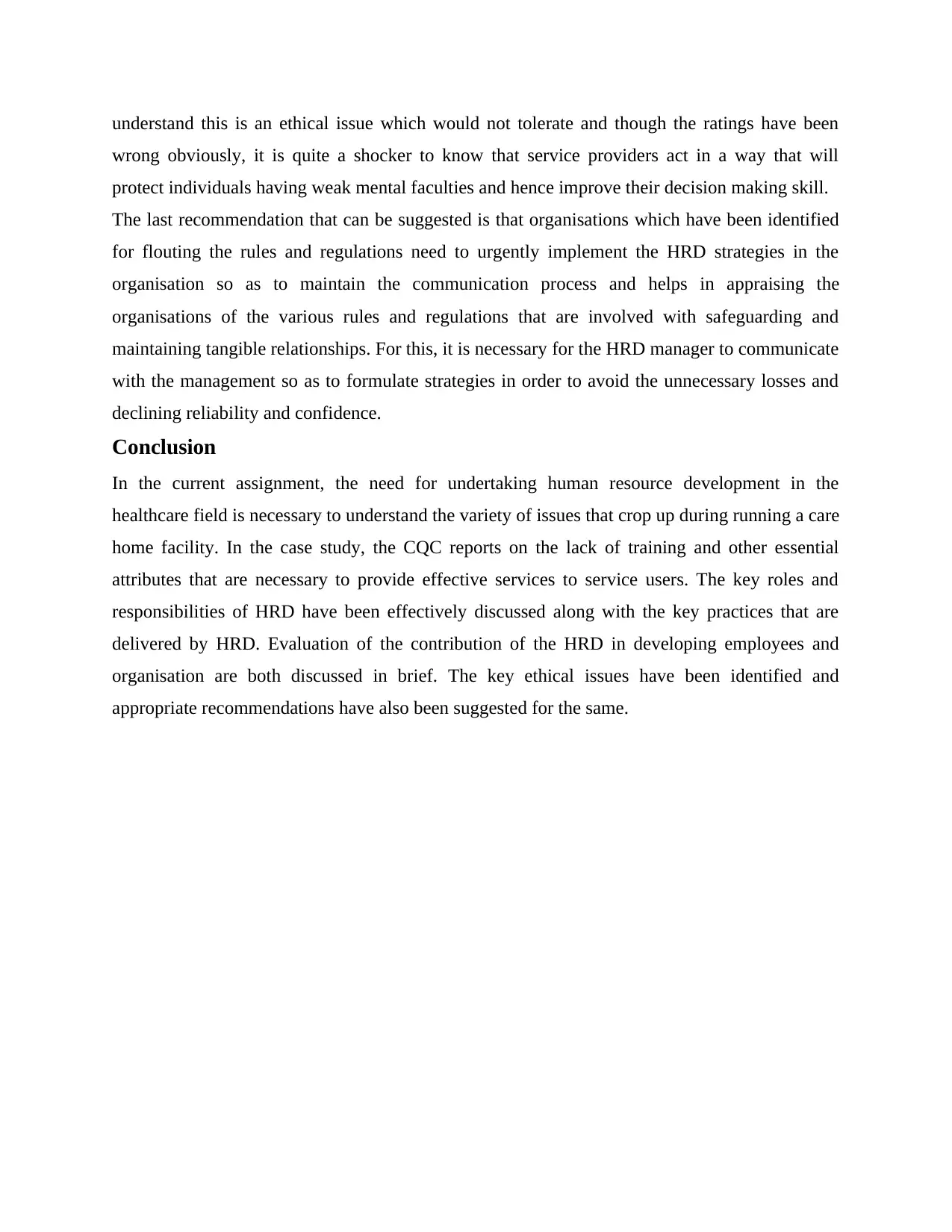
understand this is an ethical issue which would not tolerate and though the ratings have been
wrong obviously, it is quite a shocker to know that service providers act in a way that will
protect individuals having weak mental faculties and hence improve their decision making skill.
The last recommendation that can be suggested is that organisations which have been identified
for flouting the rules and regulations need to urgently implement the HRD strategies in the
organisation so as to maintain the communication process and helps in appraising the
organisations of the various rules and regulations that are involved with safeguarding and
maintaining tangible relationships. For this, it is necessary for the HRD manager to communicate
with the management so as to formulate strategies in order to avoid the unnecessary losses and
declining reliability and confidence.
Conclusion
In the current assignment, the need for undertaking human resource development in the
healthcare field is necessary to understand the variety of issues that crop up during running a care
home facility. In the case study, the CQC reports on the lack of training and other essential
attributes that are necessary to provide effective services to service users. The key roles and
responsibilities of HRD have been effectively discussed along with the key practices that are
delivered by HRD. Evaluation of the contribution of the HRD in developing employees and
organisation are both discussed in brief. The key ethical issues have been identified and
appropriate recommendations have also been suggested for the same.
wrong obviously, it is quite a shocker to know that service providers act in a way that will
protect individuals having weak mental faculties and hence improve their decision making skill.
The last recommendation that can be suggested is that organisations which have been identified
for flouting the rules and regulations need to urgently implement the HRD strategies in the
organisation so as to maintain the communication process and helps in appraising the
organisations of the various rules and regulations that are involved with safeguarding and
maintaining tangible relationships. For this, it is necessary for the HRD manager to communicate
with the management so as to formulate strategies in order to avoid the unnecessary losses and
declining reliability and confidence.
Conclusion
In the current assignment, the need for undertaking human resource development in the
healthcare field is necessary to understand the variety of issues that crop up during running a care
home facility. In the case study, the CQC reports on the lack of training and other essential
attributes that are necessary to provide effective services to service users. The key roles and
responsibilities of HRD have been effectively discussed along with the key practices that are
delivered by HRD. Evaluation of the contribution of the HRD in developing employees and
organisation are both discussed in brief. The key ethical issues have been identified and
appropriate recommendations have also been suggested for the same.
Paraphrase This Document
Need a fresh take? Get an instant paraphrase of this document with our AI Paraphraser
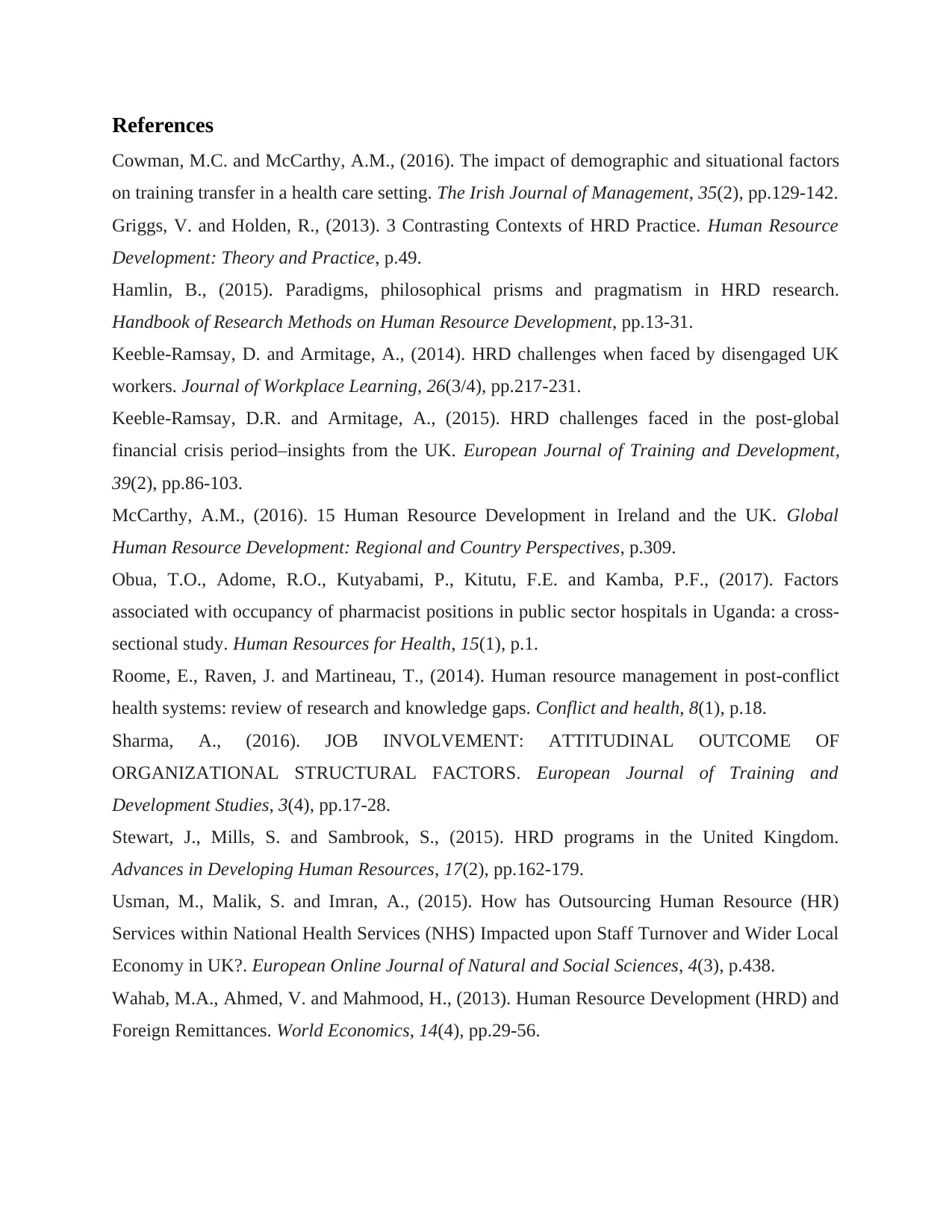
References
Cowman, M.C. and McCarthy, A.M., (2016). The impact of demographic and situational factors
on training transfer in a health care setting. The Irish Journal of Management, 35(2), pp.129-142.
Griggs, V. and Holden, R., (2013). 3 Contrasting Contexts of HRD Practice. Human Resource
Development: Theory and Practice, p.49.
Hamlin, B., (2015). Paradigms, philosophical prisms and pragmatism in HRD research.
Handbook of Research Methods on Human Resource Development, pp.13-31.
Keeble-Ramsay, D. and Armitage, A., (2014). HRD challenges when faced by disengaged UK
workers. Journal of Workplace Learning, 26(3/4), pp.217-231.
Keeble-Ramsay, D.R. and Armitage, A., (2015). HRD challenges faced in the post-global
financial crisis period–insights from the UK. European Journal of Training and Development,
39(2), pp.86-103.
McCarthy, A.M., (2016). 15 Human Resource Development in Ireland and the UK. Global
Human Resource Development: Regional and Country Perspectives, p.309.
Obua, T.O., Adome, R.O., Kutyabami, P., Kitutu, F.E. and Kamba, P.F., (2017). Factors
associated with occupancy of pharmacist positions in public sector hospitals in Uganda: a cross-
sectional study. Human Resources for Health, 15(1), p.1.
Roome, E., Raven, J. and Martineau, T., (2014). Human resource management in post-conflict
health systems: review of research and knowledge gaps. Conflict and health, 8(1), p.18.
Sharma, A., (2016). JOB INVOLVEMENT: ATTITUDINAL OUTCOME OF
ORGANIZATIONAL STRUCTURAL FACTORS. European Journal of Training and
Development Studies, 3(4), pp.17-28.
Stewart, J., Mills, S. and Sambrook, S., (2015). HRD programs in the United Kingdom.
Advances in Developing Human Resources, 17(2), pp.162-179.
Usman, M., Malik, S. and Imran, A., (2015). How has Outsourcing Human Resource (HR)
Services within National Health Services (NHS) Impacted upon Staff Turnover and Wider Local
Economy in UK?. European Online Journal of Natural and Social Sciences, 4(3), p.438.
Wahab, M.A., Ahmed, V. and Mahmood, H., (2013). Human Resource Development (HRD) and
Foreign Remittances. World Economics, 14(4), pp.29-56.
Cowman, M.C. and McCarthy, A.M., (2016). The impact of demographic and situational factors
on training transfer in a health care setting. The Irish Journal of Management, 35(2), pp.129-142.
Griggs, V. and Holden, R., (2013). 3 Contrasting Contexts of HRD Practice. Human Resource
Development: Theory and Practice, p.49.
Hamlin, B., (2015). Paradigms, philosophical prisms and pragmatism in HRD research.
Handbook of Research Methods on Human Resource Development, pp.13-31.
Keeble-Ramsay, D. and Armitage, A., (2014). HRD challenges when faced by disengaged UK
workers. Journal of Workplace Learning, 26(3/4), pp.217-231.
Keeble-Ramsay, D.R. and Armitage, A., (2015). HRD challenges faced in the post-global
financial crisis period–insights from the UK. European Journal of Training and Development,
39(2), pp.86-103.
McCarthy, A.M., (2016). 15 Human Resource Development in Ireland and the UK. Global
Human Resource Development: Regional and Country Perspectives, p.309.
Obua, T.O., Adome, R.O., Kutyabami, P., Kitutu, F.E. and Kamba, P.F., (2017). Factors
associated with occupancy of pharmacist positions in public sector hospitals in Uganda: a cross-
sectional study. Human Resources for Health, 15(1), p.1.
Roome, E., Raven, J. and Martineau, T., (2014). Human resource management in post-conflict
health systems: review of research and knowledge gaps. Conflict and health, 8(1), p.18.
Sharma, A., (2016). JOB INVOLVEMENT: ATTITUDINAL OUTCOME OF
ORGANIZATIONAL STRUCTURAL FACTORS. European Journal of Training and
Development Studies, 3(4), pp.17-28.
Stewart, J., Mills, S. and Sambrook, S., (2015). HRD programs in the United Kingdom.
Advances in Developing Human Resources, 17(2), pp.162-179.
Usman, M., Malik, S. and Imran, A., (2015). How has Outsourcing Human Resource (HR)
Services within National Health Services (NHS) Impacted upon Staff Turnover and Wider Local
Economy in UK?. European Online Journal of Natural and Social Sciences, 4(3), p.438.
Wahab, M.A., Ahmed, V. and Mahmood, H., (2013). Human Resource Development (HRD) and
Foreign Remittances. World Economics, 14(4), pp.29-56.
1 out of 11
Related Documents
Your All-in-One AI-Powered Toolkit for Academic Success.
+13062052269
info@desklib.com
Available 24*7 on WhatsApp / Email
![[object Object]](/_next/static/media/star-bottom.7253800d.svg)
Unlock your academic potential
Copyright © 2020–2025 A2Z Services. All Rights Reserved. Developed and managed by ZUCOL.




